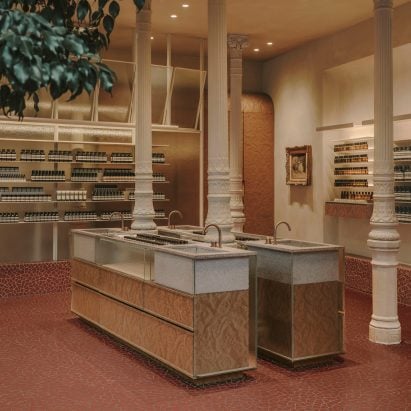Architecture studio Ciszak Dalmas and Spanish architect Matteo Ferrari have arranged ceramic mosaics and hammered glass around original decorative columns in the interiors of Aesop‘s Las Salesas store in Madrid.
Set on the ground floor of a 19th-century block in the Almagro district, the material-rich space is intended to demonstrate Aesop‘s design ethos while nodding to the city’s heritage.
“The concept was to create a retail space that seamlessly blends Madrid’s cultural and architectural heritage with Aesop’s contemporary design ethos, using craft and light to shape an immersive and transparent spatial experience,” Ciszak Dalmas told Dezeen.
Ciszak Dalmas and Matteo Ferrari designed Aesop’s Las Salesas store in Madrid
Ciszak Dalmas and Ferrari arranged the 120-square-metre store around four decorative cast iron columns that were rediscovered during the renovation.
“They are original to the building,” said Ciszak Dalmas. “In 19th-century Madrid, particularly in buildings constructed or renovated in the latter half of the century, cast iron pillars were quite common.”
“Cast iron was both strong and relatively inexpensive, making it a favoured material for structural and decorative elements.”
Trencadís-style mosaics line the floors and counters
Informed by Spanish modernism, the store’s identity comes from rich red ceramic mosaics that are used as flooring and extend up many of the walls.
The finish, which is an interpretation of the distinctive trencadís technique widely used by modernist architects Antoni Gaudí and Josep Maria Jujol, also extends up and across the checkout areas and window display plinths.
The store is arranged around four existing columns
“The design draws from Spanish modernism, notably in its reinterpretation of the trencadís mosaic technique and its proximity to Palacio Longoria,” said Ciszak Dalmas.
“This influence informed the use of ornamental surface treatments, spatial layering, and locally rooted materials to create a dialogue between tradition and innovation.”
A pair of freestanding sinks made from walnut burl wood sit at the centre
At the centre of the space are a pair of free-standing units made from walnut burl wood and thin glass, incorporating sinks topped with white granite.
A panel of Cathedral glass – a type of sheet glass with a hammered finish – is used to create a screen dividing a corridor that leads to the back-of-house areas downstairs.
“We worked with locally sourced Spanish Silvestre granito, Alpi walnut burl wood, and Cathedral glass,” said Ciszak Dalmas.
“These were chosen for their cultural relevance, tactile richness, and ability to interact with natural light, reinforcing the connection between heritage and modernity.”
A screen of Cathedral glass creates a corridor to the back-of-house areas
Through its selection of tactile materials, the team aimed to create a calm space for the store.
“The palette was guided by natural and locally sourced materials,” explained Ciszak Dalmas.
“These being warm-toned wood, textured stone, and muted ceramics, as they were selected to evoke a sense of place, serenity, and timelessness while allowing the architecture and products to coexist harmoniously.”
Other Aesop stores recently featured on Dezeen include a store in Copenhagen thats nods to the “humble” design of the nearby Louisiana Museum of Modern Art and a London store clad with bars of soap.
The post Aesop arranges Madrid store around four rediscovered cast iron columns appeared first on Dezeen.
